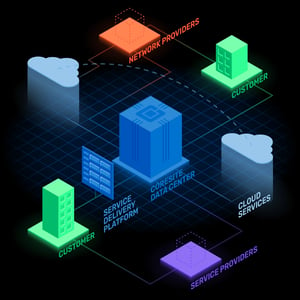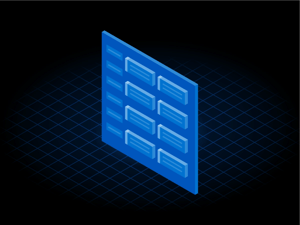INTERCONNECTION
CoreSite Open Cloud Exchange
An Interconnection Platform to Solve Digital Business Challenges
OVERVIEW
Deploy Hybrid IT Faster, Reduce Total Cost of Operation and Business Risk
CoreSite’s Open Cloud Exchange, a Finalist in the Gartner® 2023 Eye on Innovation Awards, is your “easy button” for enterprise-class network connectivity services. Simplifying hybrid cloud and site-to-site interconnection management, the Open Cloud Exchange (OCX) cuts data and broadband costs, assures business continuity and elevates cloud performance.
The Open Cloud Exchange is a software-defined networking platform designed to take the complexity out of hybrid cloud interconnection. Order a port, virtual router or ethernet virtual connection in minutes. Move data directly between clouds using Open Cloud Exchange virtual routing capabilities.
Simplify Your Network and Accelerate IT Modernization
Manage virtual cloud interconnection, services and bandwidth on-demand.REDUCE TOTAL COST OF OPERATION
The Open Cloud Exchange is offered at a flat rate, with month-to-month billing that eliminates vendor lock-in. Pricing is determined by the bandwidth (service rate) you designate, so you know exactly how much your deployment costs each month. Virtualizing complex network functions eliminates capital expenses for IT equipment.
MINIMIZE RISK
With the power to quickly recover mission-critical data through private connections to multiple clouds, you can establish the resilience you need to execute risk-reducing business continuity/disaster recovery strategies.
SPEED TIME TO MARKET
Through a single port in a CoreSite data center, enterprises can do business “virtually” everywhere. New applications can be deployed quickly across multiple markets using inter-market and inter-site connectivity. The OCX connects you with an ecosystem of enterprises, cloud and IT solutions providers and carriers that recognize the potential to deliver more value to customers by collaborating.
ACCELERATE IT MODERNIZATION
Organizations digitizing customer interactions, getting smarter with cloud or empowering developers to bring artificial intelligence into operations win in the marketplace. The OCX is a platform built to drive initiatives important to your enterprise and competitive advantage. The OCX levels the playing field, enabling companies of all sizes to infrastructure and modernize IT.
AVAILABLE IN ALL CORESITE DATA CENTERS
Reach U.S. markets using inter-site connectivity, global markets via Internet Exchanges and subsea networks.
AUTOMATED NETWORK SERVICES
How the Open Cloud Exchange Works
The Open Cloud Exchange works by providing a single port into our Layer 2 Ethernet switching platform, enabling private virtual connections (VLANs) to multiple service providers. Provisioning is done in real time - with a virtual router solution, through a private online portal. You can also connect over Layer 3, taking advantage of the inherent scalability and local area network (LAN) virtualization.
CUSTOMER SERVICE DELIVERY PLATFORM
Take Control of Interconnection – and Your Time
The Open Cloud Exchange puts you in control. Through a single pane of glass, you can order and manage virtual cloud interconnections and provision bandwidth on-demand. Instantly turn up and turn down services with a few clicks. By automating enterprise-class network services, the Open Cloud Exchange frees your IT team to focus on your competitive differentiators. Learn More
.png?width=300&name=IMAGE%20(1).png)
OPEN CLOUD EXCHANGE
Frequently Asked Questions
WHAT IS SOFTWARE-DEFINED NETWORKING?
Software-defined networking (SDN) is an approach to networking that uses software controllers, such as virtual routers and switches, that can be managed by application programming interfaces (APIs) to communicate with hardware infrastructure to direct network traffic.
WHAT IS BUSINESS CONTINUITY?
Business continuity is one element in BCDR (business continuity/disaster recovery), a proactive approach to ensuring mission-critical business operations proceed during a disruption or in the event of a disaster. Disaster recovery is a planned process used to reduce downtime and data loss if any, or all, of an IT infrastructure fails.
WHAT IS INTERCONNECTION AND WHY IS IT IMPORTANT?
Interconnection is the exchange of data between enterprises (and between an enterprise’s data centers), private and public clouds and carriers over a private network, often via a physical fiber optic link called a cross connect. Interconnection is important because it enables highly secure, low-latency and reliable data transport. Virtual interconnection is also possible, although it is not as secure or reliable.
WHAT IS THE DIFFERENCE BETWEEN NETWORK SERVICES AND INTERNET SERVICES?
Network services are applications that help control and optimize the capabilities, performance, security and orchestration of networks. Internet services are applications and protocols that enable data transmission over the internet (and the World Wide Web), made available by an internet service provider (ISP).
HOW DO I GET THE OPEN CLOUD EXCHANGE?
There are two options. First, simply contact your CoreSite sales representative to add the OCX to your deployment. It’s available as a month-to-month commitment. However, a company does not even need to be deployed in a CoreSite data center to use the OCX to manage virtual routers and data transfer. A services-only contract is available.
HOW IS OPEN CLOUD EXCHANGE PRICING DETERMINED?
Pricing is determined by the service and the service rate (bandwidth) selected. OCX services do not carry a long-term commitment and remain on a month-to-month basis until the service is disconnected. Each OCX service contains a non-recurring charge (NRC) and a monthly recurring charge (MRC) component.








